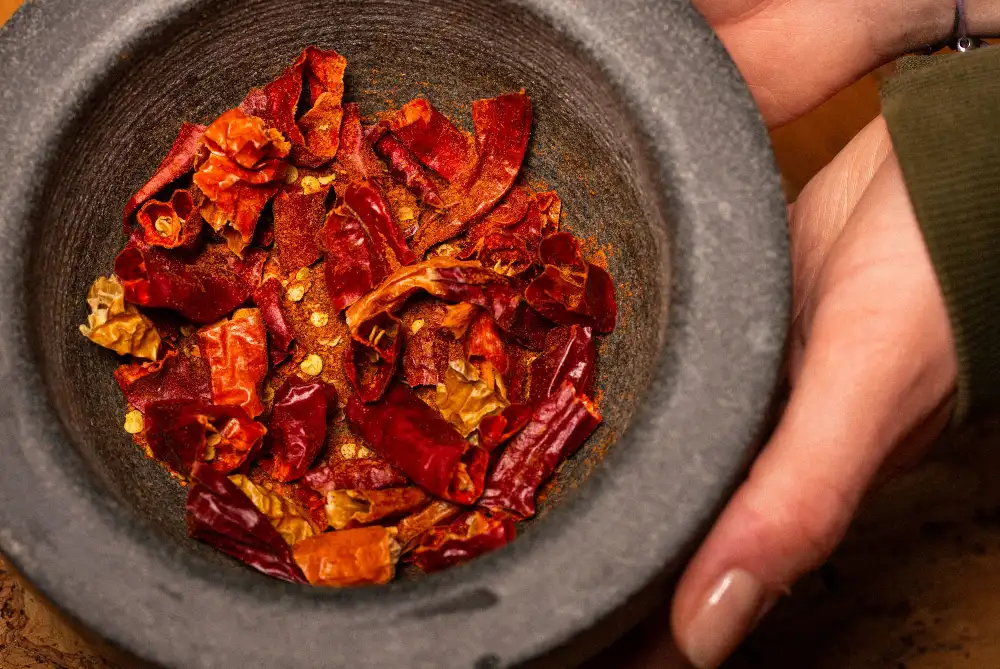Do-it-yourself: Stimulating & warming chili ointment - homemade
Preparation time: 60 min - Difficulty level: easy
- 100 ml nourishing vegetable oil, here: Almond oil
- 12-15 g pure beeswax
- vegan alternative: 6-8 g carnauba wax
- 5-15 g dried chilies or chili powder (depending on the variety - see description)
- Essential oils of your choice: We chose 10 drops of rosemary & 15 drops of cypress
- Ointment pots

Chili - promoting blood circulation and pain relief through capsaicin
The fact that chili is not only suitable for spicy dishes in the kitchen, but is also used in cosmetic and medicinal products, is probably well known by now.
Almost everyone is probably familiar with the soothing heat plasters for the back, which provide pleasant relief from muscle pain and tension.
The effect of chilli on the skin or mucous membranes is based on one of its ingredients, capsaicin.
Capsaicin belongs to the group of alkaloids, a group of substances that are mainly found in plants and are very diverse.
The effect on the body varies from alkaloid to alkaloid.
Alkaloids often provide protection against predators. This is also the case with chili peppers.
On initial skin contact, capsaicin has a burning, vasodilating and therefore also circulation-promoting effect.
This is because capsaicin binds to pain and heat receptors on the skin, activating them and causing severe irritation.
Depending on the dosage, capsaicin initially causes pain, but after prolonged use the body gets used to the stimulant and becomes less and less sensitive to it and to pain caused in other ways.
Initially, chili therefore helps well against pain that can be alleviated by a circulation-increasing effect, i.e. tension or sore muscles.
Studies show that the active ingredient in chili can also help chronic pain patients when used over a longer period of time.
The following Arte video explains once again how the spiciness of chili comes about.
Of course, you can also experience the beneficial effects of chili by making your own ointment.
With a little skill, you can make an ointment that is well suited to your individual needs.
You will need the ingredients listed above and a little experimentation, as not every chili is equally hot.
Chilli ointment - which type of chilli and which level of heat is best?
The heat of the chilli depends on the variety used and the amount of capsaicin it contains.
The effect of the ointment therefore naturally changes depending on which type of chilli is chosen and of course every skin type reacts more or less sensitively.
You should therefore find out in advance which skin type you are and perhaps start with a less spicy variety.
Chili is very variable and therefore available in many different varieties. The degree of heat is measured using the Scoville scale, which purely determines the heat of the bell pepper fruit. In the past, this was done by tasting, which was of course imprecise, as everyone has a different perception of pain. Nowadays, gas chromatography is used, which makes it possible to objectively determine the degree of pungency in the laboratory by taking measurements.



One variety that tends to be somewhat milder is the well-known chili pepper with around 1,000 Scoville. The jalapeno is a little hotter with around 5,000 Scoville.
The chayenne is already quite hot with 50,000 Scoville, but is overshadowed by habaneros, which have 250,000 Scoville and are more for the hard-boiled.
If this is still not enough for you, you should turn to the Caribbean Scotch Bonnet or the African Birdeye. However, these varieties are more for people who have little to no sensitivity to pain and who know exactly what they are doing.
Of course, there are also spicier varieties, but our ointment is intended to be soothing and not to win a spiciness competition.
Now let's turn our attention to the actual production of the ointment.
This is very simple.
Homemade soothing chili ointment - simple preparation
First, put the vegetable oil together with the good Aspermühle-beeswax in a pan and start to heat it slowly on the stove, stirring constantly. The melting point of pure beeswax is around 62-65 degrees Celsius. As soon as the wax has completely liquefied, you can turn off the heat.
Then pour a few drops of the oil-wax mixture onto a cold plate and wait briefly until the mixture has cooled to check the consistency.
If the ointment base is too solid, add a little more oil to the pot. If it is too soft, add a small amount of beeswax.
Once the right consistency has been reached, add the chili powder and essential oils to the pot and stir.
Depending on the type of chili selected, choose the right amount of chili powder. You will certainly have to experiment with this at first and only add a small amount of powder and, depending on your skin type and how you tolerate the ointment, increase the amount of chilli powder until the desired effect is achieved.
Then pour the contents of the pot into the ointment pots.
While the mixture is still liquid, you can stir it a little to prevent the chili from settling at the bottom.
Once the ointment has cooled down, you can use it.
As already described above, the chili ointment is suitable for tension and strained muscles. However, it is also suitable for a revitalizing massage on a cold winter evening.
However, please ensure that you do not get the ointment in your eyes.
Pregnant women, children, people with very sensitive skin and people with open skin areas or skin diseases should generally refrain from using the ointment.


